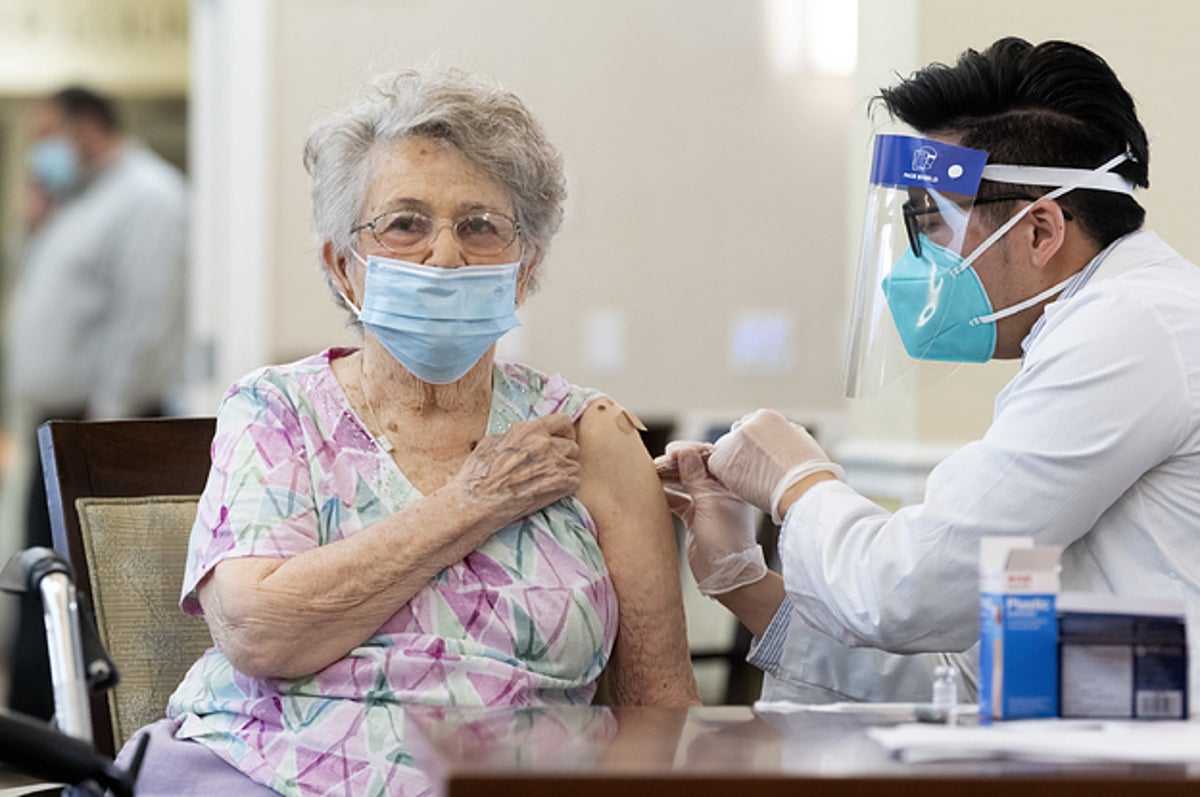Medianews Group / Getty Images
A CVS pharmacist gives the Pfizer / BioNTech COVID-19 vaccine to a resident of the Emerald Court senior community in Anaheim, California.
Vaccines are reducing the number of cases of COVID-19 in nursing homes in the United States, reported a federal health official on Thursday, a long-awaited pause in the deadly grip of the pandemic in older, more vulnerable adults.
Nursing homes have been the deadliest place for people with COVID-19 during the pandemic, killing more than 150,000 residents and employees so far. Vaccination in long-term care facilities was a high priority in the national launch of coronavirus vaccines that began in December, when COVID-19 cases reached record levels across the country and health facilities closed during the holiday. Now vaccines are starting to make a difference, suggest recently released health data, accelerating a 22% drop in COVID-19 case rates in nursing homes seen from December 20 to January 10.
“We finally feel like we have turned the tide around the holiday,” said Lee Fleisher, medical director for the Centers for Medicare and Medicaid Services, speaking on Thursday to a vaccine advisory panel at the U.S. Department of Health and Human Services.
“What we believe is starting to be shown with this data is that we are now seeing the effect of both interventions, but also of the vaccine.”
AHCA / Via ahcancal.org
Case rates of COVID-19 in nursing homes (blue) fell sharply in January, compared to the general population (red).
Cases in the COVID-19 nursing home have been the “vanguard” of the epidemic in the United States since last February, when an outbreak at a Washington state facility caused 46 deaths among residents, employees and visitors, marking the beginning of fatal cases in older adults across the country. A sign of the turn of the tide in such cases due to vaccination would not be unexpected, as data from clinical trials suggested a drop among those immunized about two weeks after the first injection, said epidemiologist George Rutherford of the University of California, San Francisco, but it is still encouraging.
“These vaccines are really good and we are seeing them working, which is wonderful,” said Rutherford. “The data showed that they were very effective even after an injection, which I suspect is what we are starting to see here.”
The evidence comes in a comparison of COVID-19 cases from the same county in 800 qualified nursing centers vaccinated against 1,7000 unvaccinated ones released on Thursday by an American Health Care Association research center. At a time when COVID-19 cases were falling across the country in nursing homes, those who received their first vaccines in the third and fourth weeks of December saw a 48% decline versus a 21% drop in non-vaccines, more than twice as sharp. fall just three weeks later, in mid-January. Among employees, the new cases of COVID-19 fell more in those who maintained the previous vaccination clinics, 33%, against those who did not, who fell 18%, in the same municipalities.
AHCA / Via ahcancal.org
More pronounced drop in case rates between facilities in the same county with previous vaccinations.
“If verified with additional data, this could speed up the reopening of long-term care facilities for visitors,” said David Gifford of AHCA, in a statement on the analysis. Even more encouraging is the evidence that vaccines help limit the spread of the virus, the association suggested.
An alternative explanation for the drop is that natural immunity has increased among health care staff simply due to the rise in infections across the country, said Rutherford. But that does not explain the division within the county in case rates between early and late vaccination facilities, making vaccines a better explanation. “It is what we expected to see,” he said.
News of vaccinations in nursing homes comes at a crucial time in the pandemic, with a new, more transmissible variant of the virus threatening to dominate across the country in March, according to the CDC. A more recent report by the federal health agency found that while normally 78% of residents in more than 11,000 nursing homes across the country received the first vaccine in the first month of implantation, only about 38% of employees did so.
A federal partnership with chains of pharmacies that administer vaccines in nursing homes will end in March. As the reluctance of the past is fading, many employees at these facilities are just getting their first chance now, said Fleisher, which will mean preparing reinforcement shots for them outside of that agreement. On Thursday, about 4.2 million injections of COVID-19 vaccine were administered in long-term care facilities in the United States, according to the CDC, almost 800,000 of them in secondary doses. According to research, Fleisher said, a major concern among these employees, many of whom are paid by the hour, is that if the vaccine causes side effects they will miss work and lose wages.
“There is a lot of suspicion, that’s why we heard about vaccines that cause infertility, sometimes even the idea of inserting a microchip,” he added. “There is a lot of misinformation.”
